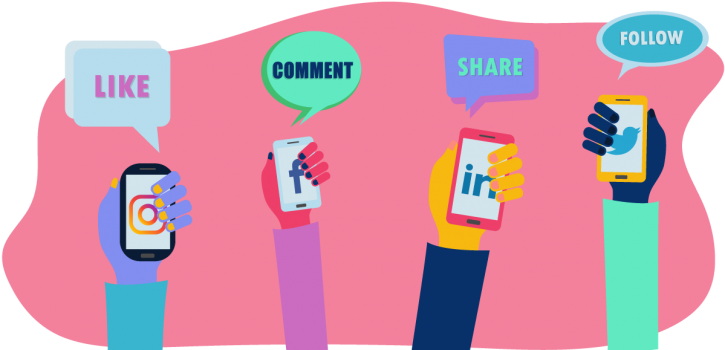Over the years, social media has become a key channel of communication and is playing an increasingly important role in businesses’ content marketing strategies. However, its use in B2B is not yet as widespread as in the B2C sector. However, social media channels are a genuine boost for advertising. They offer numerous advantages: they help you develop your brand’s online image, build your reputation and therefore generate contacts, attract prospects to products and/or services, and lastly, create customer loyalty.
In B2B, social media can be an excellent influencing factor. In fact, social media should be used from the very beginning of the purchasing cycle to generate qualified leads.
In these infographics, you’ll find a few tips to help you succeed on social media in the B2B sector.
LinkedIn: internet users’ favourite professional social networking site
Did you know that 80% of B2B leads generated on social media come from LinkedIn?
As you probably know, LinkedIn is THE most-used professional social network in the B2B sector. It is therefore important to create a full LinkedIn profile for your own use, to curate your personal branding or facilitate your job search, in addition to creating a page for your company to manage your reputation, recruit new staff or reach out to prospects.
LinkedIn has become the professional network of choice, particularly in Europe and North America. In France, LinkedIn has gradually obliterated its local competitor Viadeo; in Germany, the company, taken over by Microsoft in 2016, is gaining ground compared to Xing.
It is also an efficient prospecting tool. The platform regularly offers new features: it is possible to publish a document directly in a post to gain visibility without having to use Slideshare. The social aspect of LinkedIn has also a bit more since the arrival of reactions.
Here are some figures about LinkedIn’s importance and use:

Although LinkedIn is the most popular social network for B2B users, it isn’t the only social network out there…
Twitter: the king of mobile social media
For a few years, Twitter has been struggling to recruit new users, but it is still widely used by businesses, brands and marketing professionals. Available in 33 languages, Twitter is used more in the context of the flow of ‘hot’ information: a tweet is actually visible for an average of 4 hrs in the feed before vanishing deep into your followers’ timelines. The instant nature of the platform therefore encourages frequent posting and reactivity to make the most of rapidly changing trends and topics of conversation.
Twitter also enables effective real-time monitoring. In a B2B context, it also allows you to demonstrate your expertise and share content: by sharing your white papers, blog posts and even your customer case study videos.
Here are some figures that will make you want to use it:

The greatest advantage of Twitter is its immediacy and the interaction among its users.
Facebook: it reigns supreme… but for how much longer?
Although Facebook is the number one social network for personal use, with 2 billion active users, the platform is increasingly losing the trust of its users, partly because of poor protection of personal data and the proliferation of fake news.
Increasing numbers of young people are abandoning the platform and it is becoming more complicated for businesses to get visibility for the posts on their pages without having to resort to paid advertising. Facebook remains the social network of choice for B2C businesses because of the size of the potential audience, but it can also be a good idea to use it for B2B purposes, as prospects could be trying to find out more about your company and your business.
Clearly, Facebook should not be overlooked. Here’s some advice on using it effectively:

Facebook is still one of the social media platforms which is most used by B2B companies (86% use it as part of their social media strategy). So don’t forget about it!
Instagram: the B2C network par excellence… for the moment
These days, Instagram is a key social network, even if its use only represents 30% of B2B companies.
Instagram is not the biggest B2B social network because it doesn’t enable the generation of qualified contacts. However, it contributes to and is part of your company’s brand image. This is also the network where you can promote a different and even a more friendly vision of your company… which will help you to attract the most talented people.
Instagram can be used for any business sector and its number of active users is a great asset in gaining visibility. The platform also relies on ‘social shopping’ with integrated direct purchasing options. One of the biggest advantages of Instagram is the stories – the sharing of ephemeral (24 hrs) and personalisable content – that relates directly to users.
Instagram therefore remains an efficient communication tool. Take a look at these key figures:

You might be asking yourself whether social media is really worthwhile for B2B businesses? Statistically speaking, they are an option that can’t be overlooked. Social media is a very important tool for distributing content, building a community or even creating a new customer relationship lever.
But beware! As you can see, not all social media platforms are necessarily essential for B2B. There’s no need to rush out and create an account on each platform. It all depends on your business sector and the competitive environment…and as with any other channel, there’s no point in having a presence if you don’t have the necessary resources (human and/or financial) to devote to it.
The most important thing is to have an effective presence on social channels, without spreading yourself too thin.





